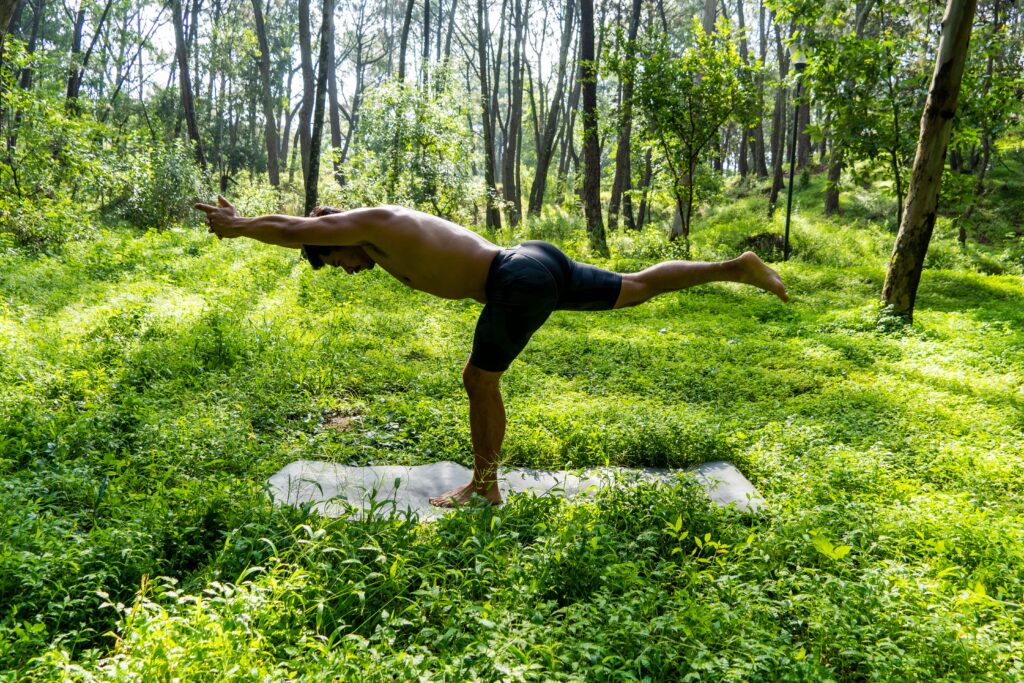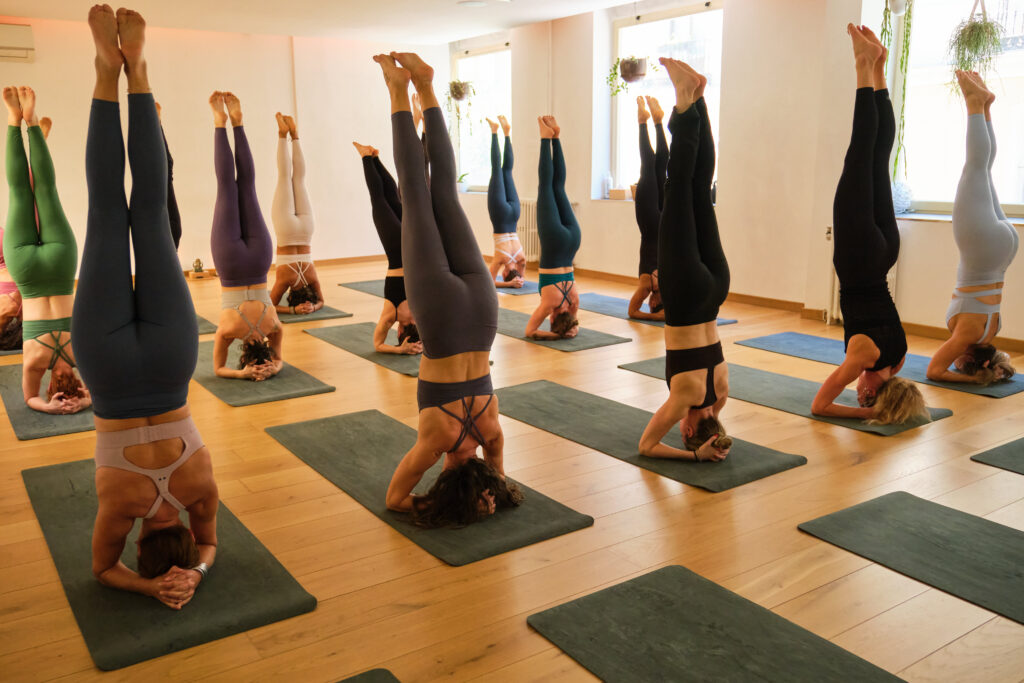Ashtanga Yoga
Ashtanga Yoga
SuryamandalaYogashala offers one of the best Ashtanga Yoga course in Mysore for all the interested seekers . Ashtanga Yoga is more than just a physical exercise; it is a holistic practice that integrates movement, breath, and meditation into a refined system that promotes both physical and mental well-being. Rooted in ancient traditions and popularized in the modern era, it offers practitioners a rigorous and disciplined approach to yoga that can lead to profound personal transformations. SuryamandalaYogashala also offer Ashtanga Vinyasa Yoga course in Mysore which is beneficial for those seeking a rigorous yet rewarding experience, enabling participants to develop strength, flexibility, and mental clarity. To summarise ,we offer a transformative Ashtanga Yoga course in Mysore, which is designed for practitioners at all levels.

Origin of Ashtanga Yoga
Ashtanga Yoga, which translates to “eight limbs” in Sanskrit, was popularized by Sri K. Pattabhi Jois in the 20th century. However, its roots trace back to the Yoga Sutras of Patanjali, an ancient text that outlines the philosophy of yoga and its eight foundational practices. These limbs include:
- Yama (ethical disciplines)
- Niyama (self-disciplines)
- Asana (postures)
- Pranayama (breath control)
- Pratyahara (withdrawal of the senses)
- Dharana (concentration)
- Dhyana (meditation)
- Samadhi (absorption or enlightenment)
The Ashtanga method emphasizes the first four limbs through a dynamic series of postures, synchronizing breath with movement to create a flowing sequence known as vinyasa. This discipline not only cultivates physical strength and flexibility but also promotes mental clarity and emotional stability.
Understanding the Ashtanga Sequence
The Primary Series: Yoga Chikitsa
The Primary Series of Ashtanga Yoga, known as Yoga Chikitsa, focuses on detoxifying and aligning the body. It comprises a series of postures that build strength and flexibility, while also promoting internal purification. This series is characterized by its traditional sequence, including sun salutations (Surya Namaskar), standing postures, seated postures, and finishing postures.
Practitioners often find that the Primary Series can be physically demanding, but it is designed to be accessible for all levels. According to a study published in the Journal of Bodywork and Movement Therapies, regular practice of the Primary Series has been shown to significantly improve flexibility by up to 30% over six months.
The Intermediate Series: Nadi Shodhana
Following the Primary Series, practitioners can advance to the Intermediate Series, known as Nadi Shodhana, which aims to purify the energy channels in the body. This series introduces more challenging postures that require greater strength and stamina while enhancing the flow of prana (life force energy) throughout the body.
The Intermediate Series is often described as a transformative phase, as it not only builds physical capacity but also deepens the practitioner’s understanding of their breath and mind. Data from various yoga research studies indicate that practitioners experience improved lung capacity and respiratory function as a result of consistent practice, with a reported increase of 20% in vital capacity after just three months of Ashtanga Yoga.
The Advanced Series: Sthira Bhaga
The Advanced Series, or Sthira Bhaga, is a culmination of strength, flexibility, and grace. This series is not only physically demanding but also requires a high level of mental focus and determination. Practitioners who reach this stage often report profound changes in their body awareness and self-discipline.
While not everyone may aspire to complete the Advanced Series, the principles learned through the practice can be applied to everyday life. A survey conducted by Yoga Alliance found that 78% of Ashtanga practitioners reported increased confidence and self-efficacy due to their commitment to the practice.
Benefits of Ashtanga Yoga
Physical Benefits
Ashtanga Yoga offers a plethora of physical benefits, including:
- Increased Strength: The dynamic movement and bodyweight resistance in Ashtanga builds muscle strength and tone. Research indicates that strength training can increase muscle mass by approximately 25% over a six-month period.
- Enhanced Flexibility: Regular practice can lead to significant improvements in flexibility. According to the International Journal of Yoga, participants in a 12-week Ashtanga program saw an increase in hamstring flexibility by an average of 35%.
- Improved Posture: The emphasis on alignment and core strength can help correct postural imbalances, reducing the risk of musculoskeletal disorders.
Mental and Emotional Benefits
In addition to its physical benefits, Ashtanga Yoga is known for its positive impact on mental and emotional health:
- Stress Reduction: The combination of breath control and movement can significantly lower cortisol levels, helping to alleviate stress and anxiety. A study in the Journal of Alternative and Complementary Medicine found that participants experienced a 40% reduction in perceived stress after eight weeks of Ashtanga practice.
- Enhanced Focus and Clarity: The practice of meditation within Ashtanga fosters improved concentration and mental clarity. Research shows that regular meditation can increase attention span and cognitive performance by up to 20%.
- Emotional Balance: Ashtanga Yoga encourages self-reflection and mindfulness, which can lead to greater emotional regulation. A survey of yoga practitioners revealed that 85% reported improved mood and emotional resilience.
The Spiritual Aspect of Ashtanga Yoga
Ashtanga Yoga is not solely a physical practice; it is deeply rooted in spirituality and self-discovery. The integration of breath, movement, and meditation allows practitioners to cultivate a deeper connection with themselves and their surroundings.
Mindfulness and Presence
The practice encourages mindfulness, teaching individuals to be present in each moment. This focus on the present can lead to greater satisfaction and fulfillment in daily life. A study published in Psychological Science highlighted that individuals who practice mindfulness report an average increase of 30% in overall life satisfaction.
Connection to Community
Practicing Ashtanga Yoga often fosters a strong sense of community among practitioners. This collective experience can lead to increased social support, which is crucial for mental health. According to the American Psychological Association, social connections can reduce the risk of mental health issues by up to 50%.
Conclusion: Ashtanga Yoga
Ashtanga Yoga is a transformative practice that offers a holistic approach to physical, mental, and spiritual well-being. With its structured sequences and emphasis on breath and mindfulness, it provides practitioners with the tools to cultivate strength, flexibility, and emotional resilience. The benefits of Ashtanga Yoga are backed by research, making it a valuable addition to any wellness routine.
Join our Ashtanga Yoga course in Mysore at Suryamandala Yogashala, where we offer a comprehensive and authentic approach to this dynamic practice.
Seekers shoud also explore our Ashtanga Vinyasa Yoga course in Mysore ,which is designed for practitioners of all levels, guiding you through the fundamental principles and techniques of this ancient discipline



